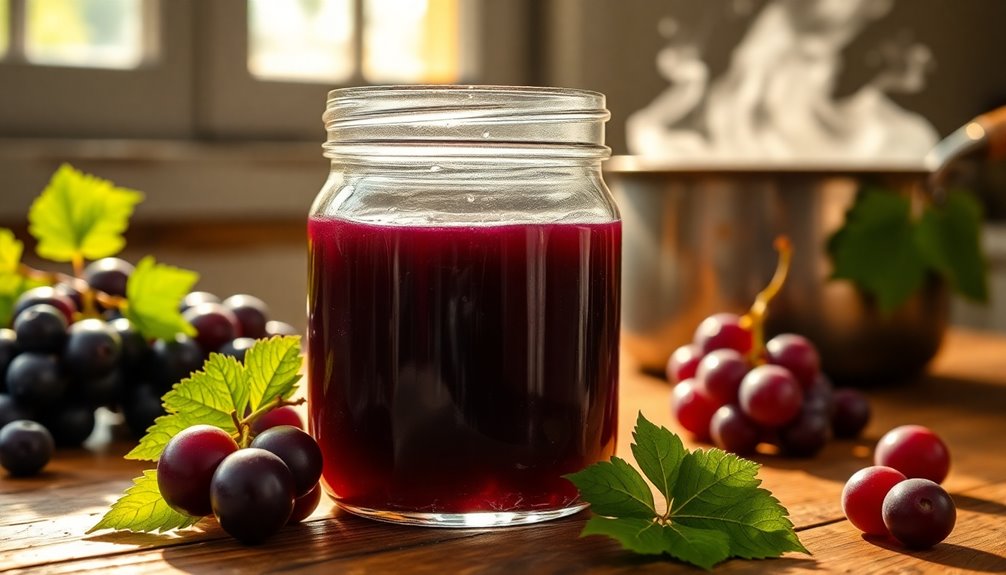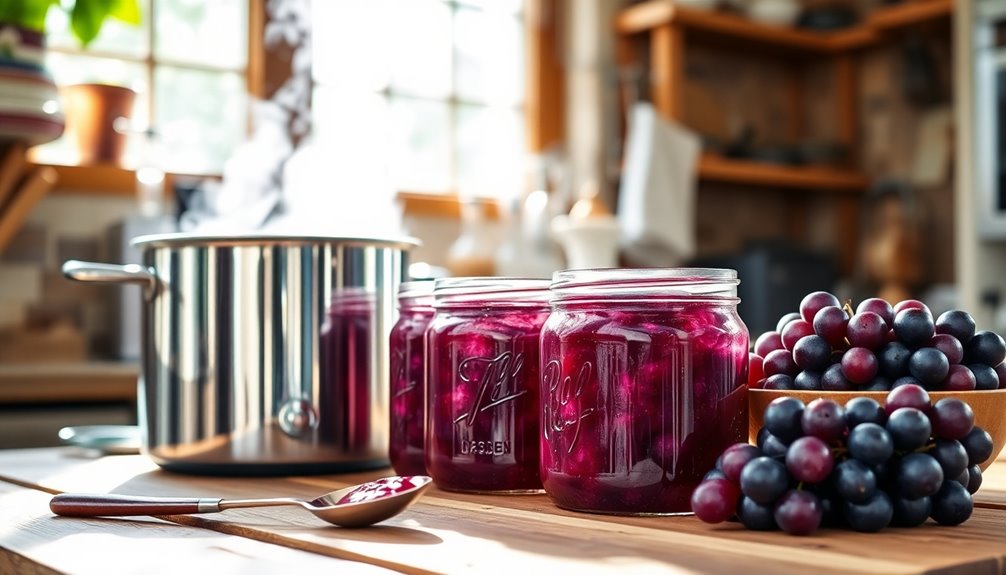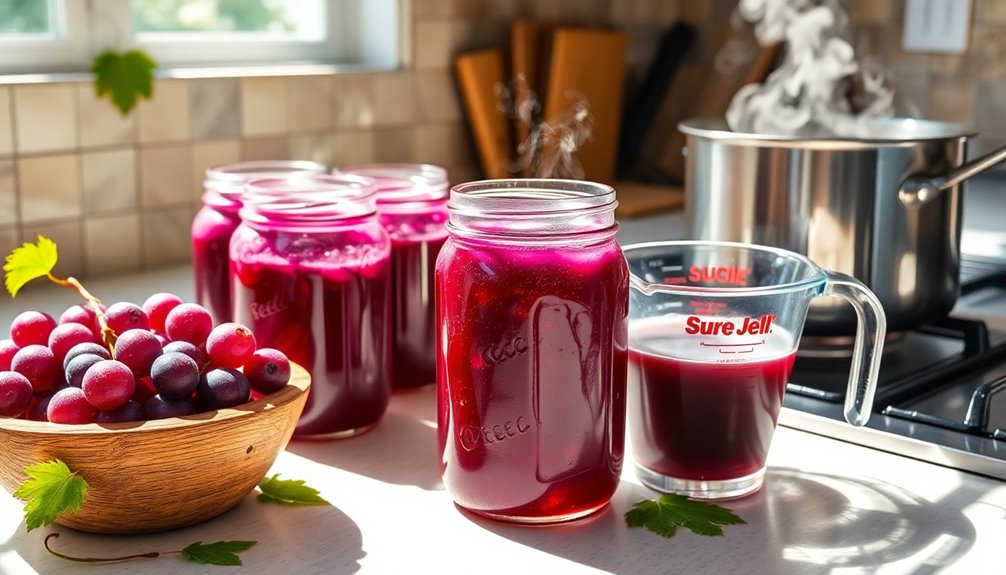You can easily make delicious grape jelly at home using this simple Sure-Jell recipe. Start by selecting 4 pounds of ripe, firm grapes, and wash them thoroughly. Boil the grapes with 1.5 cups of water for 10-15 minutes, then mash and strain for 5 cups of juice. In a pot, combine the juice with a box of Sure-Jell pectin, add a bit of butter to reduce foaming, and bring to a rolling boil. Stir in 7 cups of sugar, boil for another minute, and then pour into sterilized jars. There's even more to learn about storage and enjoyment!
Ingredients for Grape Jelly
To make delicious grape jelly, you'll need about 4 pounds of ripe grapes, which gives you around 5 cups of juice after boiling and straining. Selecting the right variety of grapes is vital; sweet table or tart grapes can greatly influence the final flavor of your homemade grape jelly.
You'll also need one 1.75-ounce box of Sure-Jell pectin to guarantee proper thickening. Many home cooks find that using expense tracking apps can help them manage their ingredient costs effectively.
Next, gather 7 cups of granulated sugar, an essential ingredient that provides the necessary sweetness and aids in the gelling process. To further enhance your jelly-making experience, consider adding ½ teaspoon of butter as an optional ingredient, which helps reduce foaming during cooking.
Once your grape juice is prepared, you'll want to have canning jars ready for sealing your jelly. You can choose to use paraffin or canning lids to keep your grape jelly fresh. Additionally, utilizing expense management apps can help streamline your kitchen budgeting for ingredients and supplies.
Step-by-Step Juicing Process
To start making your grape jelly, you'll need to select the ripest grapes, as they yield the best flavor. Utilizing budgeting tools can help you manage expenses related to your jelly-making supplies. Once you've got your grapes, you'll learn various juicing techniques to maximize the juice extraction. Additionally, using tools like expense tracking can assist in monitoring costs while you gather your ingredients. Implementing automation of expense tracking can further enhance accuracy in managing your supplies. Finally, straining is essential to guarantee you get pure juice, free of any solids.
Selecting Ripe Grapes
Selecting ripe grapes is essential for making delicious grape jelly. You'll want to choose about 3.5 pounds of ripe grapes to yield approximately 5 cups of juice, ensuring the best flavor for your homemade jelly.
Here's how to pick the perfect grapes:
- Look for grapes that are plump and firm.
- Check for deep, vibrant color; this indicates ripeness and flavor.
- Avoid any grapes that are shriveled or have brown spots.
- Smell the grapes; they should have a sweet, fragrant aroma.
Once you've selected your grapes, it's time to extract the juice. Combine the grapes with about 1.5 cups of water in a large saucepan and boil for 10-15 minutes until the grapes soften.
Use a potato masher to crush them thoroughly, allowing more juice to be extracted. Strain the crushed mix through cheesecloth to collect the juice, measuring out exactly 5 cups for your grape jelly recipe.
For a smoother final product, consider refrigerating the extracted juice overnight, helping to precipitate any tartaric acid crystals. With ripe grapes, you're well on your way to crafting the perfect grape jelly!
Juicing Techniques Explained
Juicing grapes is a straightforward process that sets the foundation for your homemade grape jelly. Start by washing and stemming 3.5 pounds of ripe grapes to guarantee all impurities are removed.
Combine the cleaned grapes with 1.5 cups of water in a large saucepan. Bring this mixture to a boil, then reduce the heat and let it simmer covered for about 10 minutes to soften the grapes.
Once softened, it's time to extract juice. Use a potato masher to crush the grapes thoroughly, releasing the juice from the pulp. This is a key step in the juicing techniques you'll use to guarantee you get the most juice possible.
After crushing, strain the mixture through a cheesecloth or jelly bag into a large bowl, allowing the juice to separate from the solids. You should yield approximately 5 cups of grape juice.
Next, measure the juice precisely and transfer it to a 6- or 8-quart saucepan. This juicing process is essential for making your grape jelly, so be sure to follow each step carefully for the best results!
Straining for Pure Juice
Straining for pure juice is an essential step in making grape jelly, guaranteeing you get a clear, flavorful base. To start, boil 3.5 pounds of cleaned and stemmed grapes with 1.5 cups of water for 10-15 minutes until they're soft. This boiling process helps to extract maximum juice from the grapes.
Once softened, use a potato masher to crush the grapes thoroughly.
Next, it's time to strain the mixture. Pour the crushed grapes through a damp cheesecloth or jelly bag, allowing the juice to filter into a large bowl. Be sure not to press the solids, as this can introduce unwanted pulp and skins, affecting the clarity and texture of your grape juice.
For ideal results, measure out exactly 5 cups of the strained grape juice before moving on to the jelly-making process.
- Use fresh, ripe grapes for the best flavor.
- Ensure your cheesecloth or jelly bag is damp to aid in straining.
- Avoid pressing the solids to maintain juice clarity.
- Discard any remaining pulp and skins for a smooth finish.
Cooking the Grape Jelly

When you're ready to cook the grape jelly, start by combining 5 cups of grape juice with one box of Sure-Jell pectin in a large pot, making sure to stir well until the pectin dissolves completely.
To help reduce foaming during the boiling process, add ½ teaspoon of butter to the mixture.
Next, bring the juice and pectin mixture to a full rolling boil over high heat, stirring constantly to maintain that boil.
Once it's boiling, stir in 7 cups of sugar all at once. It's essential to return to a full rolling boil and boil hard for exactly 1 minute while continuing to stir. This step is important for ensuring your grape jelly sets properly.
After boiling, remove the pot from heat and carefully skim off any foam from the surface using a metal spoon. This will help your finished grape jelly look smooth and clear.
Now, you're ready to ladle the jelly into jars, sealing them tightly for storage. Effective management while cooking can enhance your kitchen efficiency, making the process smoother and more enjoyable. Additionally, using the right tools can lead to better financial control in managing your kitchen expenses. Enjoy the satisfaction of homemade grape jelly, perfect for spreading on toast or using in your favorite recipes!
Filling and Sealing Jars
After cooking your grape jelly to perfection, it's time to move on to filling and sealing the jars.
Start by ladling the hot jelly into sterilized jars, filling to within 1/4 inch of the tops. This gap is essential for proper sealing. Additionally, ensure that you are using proper sterilization techniques to maintain the quality of your jelly.
Next, wipe jar rims with a damp cloth to remove any residue that might prevent a good seal. This step is crucial to minimize errors during the sealing process.
Use two-piece lids: place the flat lids in a saucepan with hot water and then on the jars, followed by the screw bands. Tighten the bands until they're finger-tight for a secure closure.
Now, place the filled jars on an elevated rack in the boiling-water canner, making sure to cover jars with water by 1 to 2 inches.
- Fill jars to within 1/4 inch of the top
- Wipe jar rims to guarantee a perfect seal
- Place flat lids in saucepan before using
- Check seals by pressing the centers after cooling
After processing, allow the jars to cool upright on a towel.
Finally, check seals by pressing the lids; they shouldn't pop back, confirming your jelly's successful sealing! Additionally, ensuring that your jars are sterilized properly can help prevent spoilage and maintain freshness.
Processing Your Jelly

To guarantee your grape jelly is safe and shelf-stable, you'll need to process the filled jars in a boiling water bath.
Place the jars in the pot, making sure the water covers them by 1 to 2 inches. Process for exactly 5 minutes. If you're at a high altitude, add one minute of processing time for every 1,000 feet above sea level to guarantee safety and preservation. AI-driven tools can help you optimize your ingredient selections based on availability and budget. Monitoring savings and investments is crucial for effective financial management, especially when planning for future canning projects.
After processing, carefully remove the jars using a jar lifter and allow them to cool upright on a towel. This promotes proper sealing.
Once they're cool, check the seals by pressing the center of each lid; a properly sealed jar shouldn't pop back, indicating a successful seal. Regular expense tracking can help you identify areas where you might save money for future canning projects.
Store your sealed jars in a cool, dark place, and they should last up to one year.
Tips for Storage and Enjoyment
For the best flavor and longevity of your homemade grape jelly, proper storage is crucial. Store sealed jars in a cool, dark place to maintain flavor and prevent spoilage, allowing them to remain shelf-stable for 12-18 months.
If you've opened a jar, refrigerate unsealed jars immediately and enjoy them within 3-4 weeks for ideal freshness and safety.
If you prefer a sweeter taste, don't hesitate to experiment with adjusting sugar levels, but remember to keep the necessary 1:1 ratio of juice to sugar for proper setting.
For long-term enjoyment, consider freezing your grape jelly, which can extend its freezing shelf life up to 6 months while preserving its delicious flavor and texture. Additionally, opting for sustainable packaging solutions when storing your jelly can contribute to reducing waste.
To fully enjoy your grape jelly, try these ideas:
- Spread it generously on warm toast.
- Use it as a delightful filling for pastries.
- Mix it into yogurt for a sweet twist.
- Drizzle it over pancakes for a fruity kick.
With these tips, you'll guarantee your grape jelly not only stays fresh but also brings joy to your meals!
Conclusion
Now that you've transformed fresh grapes into luscious jelly, you can savor the sweet reward of your efforts. The vibrant color and rich flavor stand in stark contrast to store-bought options, which often lack character. Each jar represents not just a delightful treat, but also the joy of creating something unique at home. So, spread that homemade grape jelly on your morning toast or indulge in a spoonful—your taste buds will thank you for this delicious adventure!



